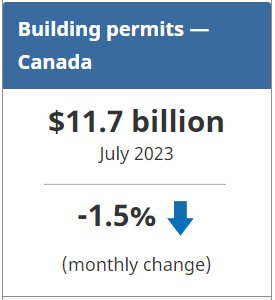Statistics Canada: Building Permits July 2023
The total monthly value of building permits in Canada declined 1.5% in July to $11.7 billion despite a monthly gain of 5.4% in the residential sector.

On a constant dollar basis (2012=100), the total value of building permits was down 3.5% to $6.7 billion.
Residential permit values up with third consecutive increase in single-family buildings
The total monthly value of residential permits increased 5.4% to $7.4 billion in July. Ontario (+23.9% to $3.5 billion) contributed the most to the rise in value of both single-family and multi-family dwelling permits.
Across Canada, July marked the third consecutive monthly increase in single-family home permits, up 7.6% to $2.8 billion. This prolonged uptick followed a year of trending decline in construction intentions for single-family homes from May 2022 to April 2023.
Overall, multi-family dwellings construction intentions led the residential gains in Ontario, Manitoba, Nova Scotia, Saskatchewan, New Brunswick and Prince Edward Island, the six provinces that posted growth in residential permit values in July.
Across Canada, permits for 22,300 new dwellings were issued in July. This amounts to a cumulative total of 150,400 new intended units in 2023, 10.9% less than the 168,800 new intended units from permits issued from January to July 2022.
Non-residential construction intentions down across all components
The total monthly value of non-residential permits declined 11.5% to $4.3 billion in July, following some exceptionally high valued hospital permits issued in June. As a result, the institutional component was down 19.7% to $1.3 billion in July.
Construction intentions in the commercial component were also down (-10.8% to $1.9 billion) in July, while the industrial component posted more modest declines (-1.0% to $1.1 billion).
To explore data using an interactive user interface, visit the Building permits: Interactive Dashboard.
For more information on construction, please visit the Construction statistics portal.
For more information on housing, please visit the Housing statistics portal.
Statistics Canada has a Housing Market Indicators dashboard. This web application provides access to key housing market indicators for Canada, by province and by census metropolitan area. The indicators are updated automatically with new information from monthly releases, giving users access to the latest data.
Note to readers
Unless otherwise stated, this release presents seasonally adjusted data with current dollar values, which facilitate month-to-month and quarter-to-quarter comparisons by removing the effects of seasonal variations. For information on seasonal adjustment, see Seasonally adjusted data – Frequently asked questions.
Building components
- Single-family dwellings: Residential buildings containing only one dwelling unit (e.g., single-detached house, bungalow, linked home [linked at the foundation]).
- Multi-family dwellings: Residential buildings containing multiple dwelling units (e.g., apartment, apartment condominium, row house, semi-detached house).
- Industrial buildings: Buildings used in the processing or production of goods or related to transportation and communication.
- Commercial buildings: Buildings used in the trade or distribution of goods and services, including office buildings.
- Institutional and government buildings: Buildings used to house public and semi-public services, such as those related to health and welfare, education or public administration, and buildings used for religious services.
Revision
Data are subject to revisions based on late responses, methodological changes and classification updates. Unadjusted data have been revised for the previous month. Seasonally adjusted data have been revised for the previous three months.
With this release, data from January 2023 to March 2023 have also been revised.
For information on trend-cycle data, see the StatCan Blog and Trend-cycle estimates – Frequently asked questions.
Next release
Data on building permits for August will be released on October 11.
Source: Statistics Canada






